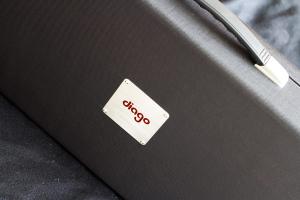 A while back I started talking with James Kitchen of Diago Pedal Boards out of England. He sent over a few items for me to check out, namely the Diago Gigman PB-02 pedal board.
A while back I started talking with James Kitchen of Diago Pedal Boards out of England. He sent over a few items for me to check out, namely the Diago Gigman PB-02 pedal board.
The first thing that caught my eye about the pedal board, was that it was very clean and pro. I dug the name plate on the face, steel corner protection and latching allowing for the top portion to easily come off. I also liked the material that the pedal board was covered in. I was expecting a tolex type of material, but there is a polyweave cloth. Very sharp looking. I was also surprised with the weight of the pedal board. The material is 1/2″ Eastern plywood, but is very stiff, strong, and light.
The entire floor portion is a velcro-friendly material allowing your pedals to anchor securely to the board. The board is incredibly simple which allows for a few things. No need for a case for the pedal board, since the case is basically the board itself and also the lid. Pedal placement and routing options are all up to you. The basis of this board is to keep things simple, and they achieved this while keeping a classy look.
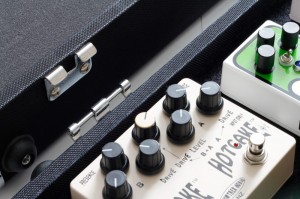 Diago makes three different size of pedal boards. The Gigman (photos shown in this post), Showman and Tourman. The Gigman can hold approximate 8-10 Boss sized pedals. The Showman can hold 12-16 and the Tourman can hold up to 30. The Gigman will run you about $140 USD. If you’re interested in purchasing a Diago Pedal Board, be sure to check out their dealer page. You can buy them all over the world!
Diago makes three different size of pedal boards. The Gigman (photos shown in this post), Showman and Tourman. The Gigman can hold approximate 8-10 Boss sized pedals. The Showman can hold 12-16 and the Tourman can hold up to 30. The Gigman will run you about $140 USD. If you’re interested in purchasing a Diago Pedal Board, be sure to check out their dealer page. You can buy them all over the world!
I asked James about the pedal boards, and he sent me a great email about why he started to design the pedal boards:
I come from a design engineering background. In 2005 I was starting out in a band and the other guitar player and I needed pedal boards. I looked around at what was available, and I just couldn’t find anything that I liked – there was nothing that really fit my list of criteria.
Most of the low cost boards were either moulded plastic or really cheaply made flightcase types that were just utter rubbish. Some could only accept one brand or size of pedals, in some you could only put
pedals in certain places, but most of all the overall the quality was just bad. They were the kind of thing that looks good at a distance or on the internet, but when you get up close, they’re just poorly thought out and poorly made. I hate that.The alternative was to have a custom made board and flight case made. The problem with them is that the case is usually way bigger than the board, the board has to come out of the case, the case has to be stored in the garage…because my girlfriend really doesn’t like them, and they damage the interior of your car. I wanted a more elegant solution.
So, being an engineer and guitar player, I did what comes naturally. I sat down and thought about all the things that I thought were and were not important and over the next few weeks, designed a pedal board that I wanted to buy. It had to be strong, rigid, relatively light weight, look great, base board covered entirely with velcro so that my pedals can go where I want, be quick to set-up and take-down, provide hardcase protection and have tough, great quality hardware. After a bunch of prototype iterations, I eventually settled on the design we have now. It’s simple, tough, easy to use and does everything I want it to, and nothing more.
There are no silly, superfluous features. I think that’s a problem with designers and sales guys sometimes; they always want something new and innovative. They want more features, or some wacky feature to talk about. That annoys me, because the customer is not getting what he (or she) really wants, they’re just getting the result of someone’s ego and marketing BS. Innovation should be focused on user needs, and that’s sometimes best done by getting rid of the unnecessary and improving quality. That’s something that Apple seem to do so well and I have a lot of respect for their approach to product design.If you take a product design and then over the years add a ton more features, but need to sell it at the same price; it’s inevitable that the quality goes down – since there’s less money available to spend on each element. I see it everywhere these days. So, in the same way, by thinking hard, considering the needs of the user and matching them up with materials and manufacturing processes, it’s possible to make a product that does all the things it needs to, at a reasonable price. Deciding what not to do is as important as, and part of, choosing what to do.
We take the same approach to everything we design. Firstly, what does the user need? What would make his (or her) life easier? Then we look at all the design and technical possibilities to meet those needs. It’s a simple process really, but done properly it takes a great deal of time and effort to end up with a great product.
One thing that we’ve been asked for, many times, is the ability to raise the back row of pedals. We get a lot of emails with product ideas and I always record them to see if there’s a consensus on something that we should be doing that we’re not. This is one of those situations, so we’ve come up with a really great and easy to use design: it’s kind of like Lego. The pieces are essentially building blocks so that users can build a pedal riser of the size and height that they want. The blocks are reasonably priced too (about $6 each, street), so building larger platforms are be realistic too. These Diago Pedal Risers will be out next month.In 6 years we’ve gone from me selling the pedal boards on eBay, to Diago being available in about 30 countries. So we must be doing something right. We also have a few more great products out and a bunch more interesting things in development, all pedal board oriented… We’ll be announcing the next ones pretty soon.
Be sure to check out Diago at their website, on Facebook and on Twitter. I’ll be talking about a few other Diago products in the near future, so keep your eyes out for those!

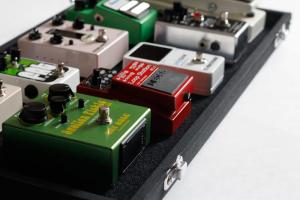
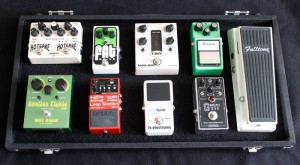

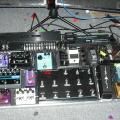
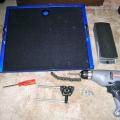

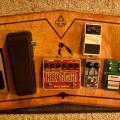
Leave a Reply